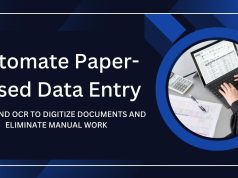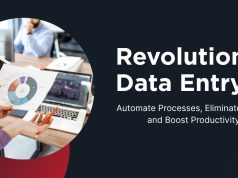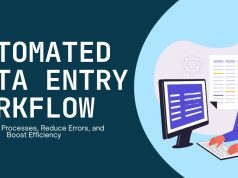Manual data entry is one of the most time-consuming tasks in business operations. If you’re copying information from Excel spreadsheets to websites dozens or hundreds of times each day, you’re not alone—and you’re not working efficiently.
Automation can transform this tedious process into a streamlined operation that saves hours of work while reducing errors. This guide will walk you through multiple methods to automate data entry from Excel to websites, from simple browser extensions to advanced programming solutions. Whether you’re a beginner or have technical experience, you’ll find practical approaches that fit your skill level and budget.
Understanding Data Entry Automation Options
Data entry automation ranges from basic copy-paste tools to sophisticated software solutions that can handle complex workflows. The right choice depends on your specific needs, technical comfort level, and the complexity of your data transfer requirements.
Simple automation might involve browser extensions that can fill web forms with a few clicks. More advanced solutions use programming languages like Python or specialized software to handle large-scale data transfers automatically.
Before diving into specific tools, consider your current workflow. How often do you transfer data? Are you working with the same websites repeatedly? Do you need to manipulate data before entering it? These factors will help determine which automation approach works best for your situation.
Browser Extensions for Simple Form Filling

Autofill Extensions
Browser extensions offer the quickest way to start automating data entry. Extensions like Form Filler, Autofill, or RoboForm can store frequently used information and populate web forms with a single click.
These tools work well for repetitive form filling where you’re entering the same information repeatedly. Set up templates with your common data fields, then use keyboard shortcuts or toolbar buttons to populate forms instantly.
Most autofill extensions allow you to create multiple profiles for different types of forms. You might have one profile for customer information, another for product details, and a third for financial data. This organization makes it easy to select the right data set for each situation.
Advanced Form Automation
For more complex needs, consider extensions like iMacros or Selenium IDE. These tools can record your actions on websites and replay them automatically. Record yourself filling out a form once, then run that recording to complete identical forms in the future.
These solutions handle dynamic websites better than simple autofill tools. They can navigate through multiple pages, handle dropdown menus, and even wait for pages to load before continuing with data entry.
Excel-to-Web Integration Tools
Microsoft Power Automate
Microsoft Power Automate (formerly Microsoft Flow) provides powerful integration capabilities between Excel and web applications. Create automated workflows that trigger when Excel data changes, then update websites accordingly.
Power Automate works particularly well with Microsoft ecosystem tools like SharePoint, Dynamics 365, and Office 365. However, it also connects with hundreds of third-party web applications through pre-built connectors.
Set up flows that monitor Excel files for changes, then automatically post updates to your website’s database or content management system. This approach works well for inventory updates, customer information changes, or content publishing workflows.
Zapier for Cross-Platform Automation
Zapier connects Excel with thousands of web applications through simple automation rules called “Zaps.” Create workflows that trigger when new rows are added to Excel spreadsheets, then automatically create records in your web applications.
Popular Zapier integrations include adding Excel data to CRM systems, updating e-commerce product listings, or creating social media posts based on spreadsheet content. The platform handles the technical complexity while you focus on designing the workflow logic.
Most Zapier integrations work with cloud-based Excel files through OneDrive or Google Sheets. This requirement ensures that automation triggers can detect changes in your spreadsheets in real-time.
Programming Solutions for Advanced Automation

Python with Selenium
Python programming combined with Selenium WebDriver provides the most flexible solution for complex data entry automation. This approach can handle virtually any website interaction, from simple form filling to complex multi-step processes.
Selenium can open web browsers, navigate to specific pages, locate form fields, and enter data from Excel files. The pandas library makes it easy to read Excel data in Python, while Selenium handles the web interaction portion.
This solution requires programming knowledge but offers unlimited customization. You can handle complex logic, error checking, and data validation that simpler tools cannot manage.
VBA Macros for Excel Integration
Visual Basic for Applications (VBA) macros can automate data transfer directly from Excel to web applications. This approach keeps everything within the Excel environment while adding powerful automation capabilities.
VBA can control Internet Explorer or other web browsers to navigate websites and fill forms. While not as flexible as Python solutions, VBA macros are often easier for Excel users to understand and maintain.
Create custom buttons in Excel that trigger data transfer macros. Users can select specific rows or ranges of data, then click a button to automatically transfer that information to designated websites.
API-Based Data Transfer
REST API Integration
Many modern websites offer Application Programming Interfaces (APIs) that allow direct data transfer without interacting with web forms. APIs typically provide faster, more reliable data transfer than form-based automation.
Research whether your target websites offer APIs for data submission. Common examples include e-commerce platforms, CRM systems, and content management systems that provide API endpoints for creating and updating records.
API integration typically requires technical knowledge but offers the most robust automation solution. Data transfers happen in the background without opening web browsers, making the process faster and less prone to errors.
Database Direct Connections
Some websites allow direct database connections that bypass web interfaces entirely. This approach works well for large-scale data transfers where web forms would be impractical.
Database connections require technical expertise and proper security measures. However, they provide the fastest data transfer method and can handle thousands of records efficiently.
No-Code Automation Platforms
Integromat (Make)
Integromat offers visual workflow builders that connect Excel with web applications without programming. Drag-and-drop interfaces make it easy to create complex automation workflows without coding knowledge.
The platform handles data transformation, error handling, and scheduling automatically. Create workflows that run on schedules, respond to triggers, or execute manually when needed.
Integromat’s visual interface makes it easy to understand and modify automation workflows. Team members can collaborate on automation projects without requiring programming skills.
IFTTT for Simple Workflows
If This Then That (IFTTT) provides simple automation rules for basic data transfer needs. While less powerful than other platforms, IFTTT’s simplicity makes it accessible to users without technical experience.
IFTTT works well for simple triggers like “when a new row is added to a Google Sheet, create a post on social media” or “when Excel data changes, send an email notification.”
Choosing the Right Automation Method
Consider your technical skill level when selecting an automation approach. Browser extensions and no-code platforms offer quick wins for users without programming experience. Programming solutions provide more flexibility but require additional learning time.
Evaluate the complexity of your data transfer requirements. Simple form filling might only need browser extensions, while complex workflows with data validation and error handling might require programming solutions.
Think about scalability and maintenance requirements. Simple tools might work for small-scale operations, but growing businesses often need more robust solutions that can handle increased data volumes and complexity.
Implementation Best Practices
Start Small and Scale Gradually
Begin with simple automation projects to learn the tools and processes. Automate one specific data transfer workflow before expanding to more complex scenarios.
Test automation thoroughly with sample data before using it with important business information. Create backup procedures in case automation fails or produces unexpected results.
Data Validation and Error Handling
Implement validation rules to ensure data accuracy before transfer. Check for required fields, proper formatting, and reasonable value ranges.
Plan for error scenarios like network timeouts, website changes, or invalid data formats. Good automation includes error handling that logs issues and provides clear feedback about problems.
Security Considerations
Protect sensitive data during automation processes. Use secure connections, encrypt stored credentials, and limit access to automation tools.
Regularly review and update automation credentials. Remove access for former employees and audit automation permissions periodically.
Measuring Automation Success
Track time savings from automation implementation. Calculate the hours saved per week or month to demonstrate the value of automation investments.
Monitor data accuracy improvements. Good automation should reduce errors compared to manual data entry processes.
Measure the impact on employee productivity and job satisfaction. Automation should free up time for more valuable activities and reduce repetitive work stress.
Transforming Your Data Entry Workflow
Automation transforms tedious data entry from a time-consuming chore into an efficient, reliable process. The key is choosing the right tools for your specific needs and implementing them systematically.
Start by evaluating your current data entry requirements and identifying the best automation approach for your situation. Whether you choose simple browser extensions or advanced programming solutions, the time invested in setup will pay dividends in improved efficiency and reduced errors.
Remember that automation is an ongoing process. As your business grows and changes, your automation needs will evolve too. Stay flexible and be prepared to upgrade or modify your automation tools as requirements change.
Automating data entry from Excel to your website can save time and reduce errors, especially as your business scales. When combined with data-driven marketing solutions, these efficiencies can help unlock growth by streamlining operations and making smarter, insight-led decisions.










